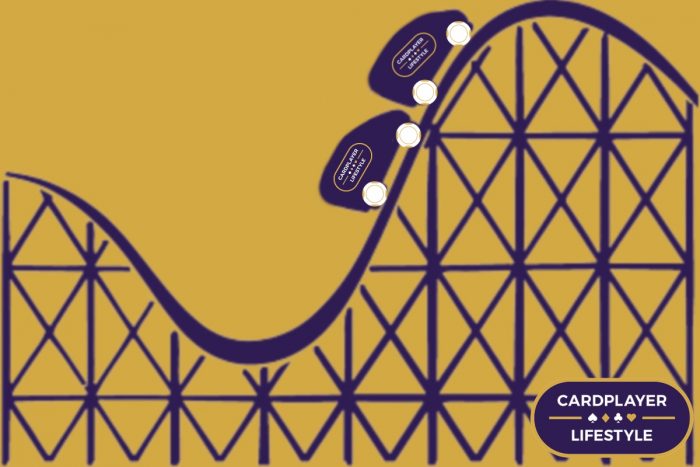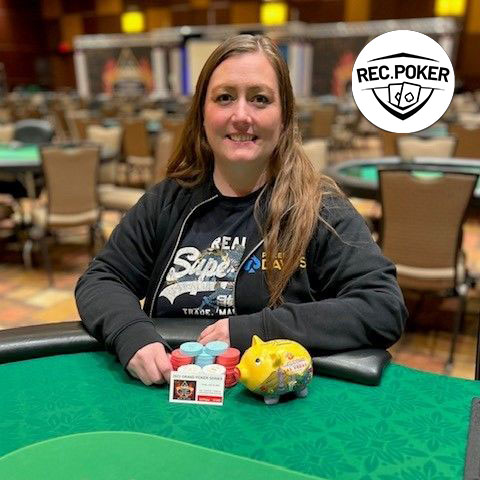Downswings suck. Unfortunately if you play the game regularly you are bound to experience a poker downswing. A downswing in poker is when you go on a losing streak. It could last a couple of sessions, it could last a couple of months, or even longer. No matter how long a downswing lasts, it is not a good time. Most downswings follow a similar pattern that most players have experienced at some point.

Phase 1: Variance
You play a few sessions in a row that don’t go your way. Looking back, you stand by all your decisions, but the cards just weren’t falling your way. You missed all your high equity draws, you lost your flips, and your strong preflop hands just didn’t connect. You wouldn’t do anything differently, but things just didn’t work out in your favor. This marks the beginning of a downswing. At this point, variance is to blame.
Poker, of course, involves luck. Smarter people than I discovered after roughly 1,600 hours of play, luck has little impact on your results. So once you have played this many hours, your results are highly correlated to skill. If you often get the money in with high equity you will win, and if the opposite is true you will be lose. When you consider an isolated number of hours, you may fall on the good or bad side of variance. If you are on a downswing, but still getting your money in with the right amount of equity, variance is the likely culprit.
Poker downswings suck, but they are guaranteed to happen at some point if you play often. There will be times when you are making correct decisions but still losing hands. It’s all part of the game and being able to weather the storm is necessary to play poker regularly. Eventually, you will end up on the right side of variance. If you play enough poker, you will come out the other side.
If you continue to attack the game with an analytical mind and winning strategies, you will make it out of the dark downswing tunnel and back into the light of run good. If you can push through without variance affecting your play, congratulations! Your downswings will end at phase 1. However, if the bad beats and coolers start to get into your head and affect your decision-making abilities, you may move into phase 2.
Phase 2: Altering Your Play
After being beaten up over enough hours, you may find yourself second-guessing your strategy. It is a common occurrence in which players feel the weight of a poker downswing and start to adjust their play. Some players may fold draws more often, even when getting the right price. Others will check back a river instead of betting for value to keep the pot small. It could be as simple as tightening up preflop ranges or flat calling an open with a hand you should 3-bet. All of these strategy changes have one thing in common: they are done to conserve money.
If you find yourself making decisions like the above to keep pots small and mitigate risk, you are officially in stage 2 of your downswing. At this point, the money you have lost is getting into your head. You are actively trying to keep pots smaller or avoid drawing so you don’t have to risk more money. Poker inherently comes with risk. You must be willing to put chips in the middle if you want to win. By making these risk-intolerant decisions you are sacrificing your win rate. Sure, you may save money when flopping a draw, but you are losing money by not realizing your equity, or value betting when you have the best hand.
This is the point where you should be analyzing your decision-making and getting back to what has worked in the past. If you find yourself altering your playing style just because you are on a downswing, maybe it is time to step back and take a break. Do some studying off the felt and get back to a strategy that works. The quicker you get back to your normal game, the quicker your downswing should end. If you don’t, you may find yourself in the dreaded phase 3.
Phase 3: Full Blown Tilt
The third and final phase of a downswing is one no player wants to enter. This is the full-blown tilt phase. Most players have caught themselves playing tilted in a session, but this is different. This is some long-term tilt that lasts multiple sessions and it is dangerous.
At this point in a downswing, your poker game is devoid of all thought and strategy. You may be playing practically any two cards, chasing every single draw, and making wild bluff attempts. This is when you feel the need to claw back every cent you lost during the downswing and will do it at all costs. Typically, the costs include losing a lot more money.
If you find yourself in this phase of a downswing, STOP PLAYING. Take a much-needed break from the game until you’ve had time to clear your head and get back to playing with a sound strategy.
While every player will experience phase 1 of a downswing, you don’t have to enter phase 2 or 3. If you pay attention to your game and thought patterns while playing, you can avoid your downswing spiraling into full-blown tilt.
READ ALSO: Finding #Positivity in a Downswing – An Ode to the Poker Brat
Here are 5 Tips and Tricks for Handling Downswings
1. Practice Good Bankroll Management
The first and foremost tip for dealing with a downswing is to be properly bankrolled. For a live cash game player, it is not uncommon to go on a 10-15 buy-in downswing, so being properly rolled is necessary to ride the waves of variance. If you are hoping to become a professional poker player, you must be properly rolled for the stakes you play for this very reason. If you are a recreational player, you may not have a proper bankroll for your stakes. I have never really had a conventional bankroll for $1/$2, but that is because I have a full-time job and don’t get to play live poker often. I am fully aware that at any given time my small $2,000-$3,000 bankroll could be wiped out by a downswing. It is something all recreational players need to be prepared for when playing without a true bankroll.
Being properly rolled helps you avoid your downswing moving into phase 2 or 3, since you don’t have money pressure. No matter how much money you have, if your poker bankroll is getting close to empty, you will likely feel pressure to not go broke. This can lead to altering play and possibly going on full-blown tilt. To weather downswings, make sure you are properly rolled or have income you can use to pump that bankroll up in the event of a downswing.
2. Study
Studying is incredibly important in poker. To beat the game, you need to understand the game. Whether you are studying by enrolling in a class on one of the best poker training sites, working with a GTO solver and HUD log of your online hands, or talking through tough spots with good players, studying is necessary to improve in poker. If you find yourself amid a downswing, replace some of your playing time with study time. This can help you accurately diagnose whether the downswing is due to mistakes in your game or variance. If it is the latter, simply continue playing as you are but still take the time to study. If you are making mistakes, work to plug those leaks! A study break will give you some needed time off the felt while keeping your mind involved in poker.
3. Game Selection
When experiencing a downswing, make sure you are playing good games. If you find yourself in a snoozefest of a game where you can’t get any action on your strong hands, this likely isn’t the game that will reverse the downsizing. On the other side, if your downswing has taken a large chunk out of your bankroll, consider dropping down in stakes to mitigate the variance. Lastly, if you play multiple games, consider playing in those that have less variance. For example, I play both NLH and PLO, but if I’m on a heavy downswing I will generally stay away from the PLO tables as there is more variance in that game. By focusing on NLH I can work to grind my way out of the downswing before peeling four cards.
4. Take a Break
An important way to combat a downswing is to just take a break from the game. I don’t mean take time off the felt to study, I’m talking about a true break. Don’t play, don’t study, don’t even watch televised poker. Take some time for yourself and do other activities. If you are like me and poker is your only pastime, try to find a new hobby. Whether the break is for a day or for a few weeks, sometimes you just need to reset your brain and stay away from the game for a while. If you find yourself in the first phase of a downswing and you still stick by your plays, you may not need a break. This is really for when you find yourself in the second or third phase. If you are altering your play to avoid risks you should be taking, or find yourself as a raging tilt monster, a break is a great way to get your head back to where it needs to be.
5. Maintain Focus and Regulate your Mood
Poker is a strategic game. To enact the best possible strategy, you need to be focused and your emotions need to be in check. It can be hard to have a clear mind when you are in the middle of a downswing. There are a few things you can do to make sure you are level-headed and ready to battle. Ditch the distractions, so take those headphones out and put the phone away. Take short walks when needed, they can help clear your mind after a cooler or bad beat. Come to the game after eating a solid meal and getting a good night’s sleep. When on a downswing, you don’t want to be playing tired or hungry.
Downswings are inevitable. If you play long enough, you will go on multiple downswings over your career. Just make sure you are playing well and you are properly bankrolled. If you keep making positive EV plays, the variance will eventually turn around. If you find yourself sneaking into the second or third phases of a downswing, use these tips to keep a clear mind and get back to playing a winning strategy.




